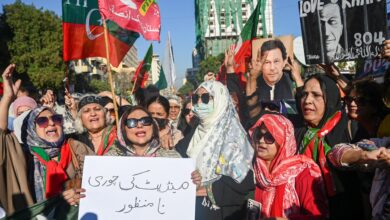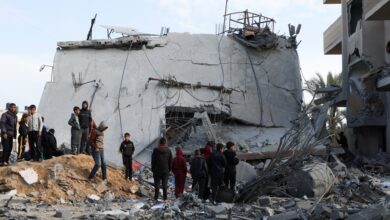How an impasse in the South China Sea drove the Philippines, US closer
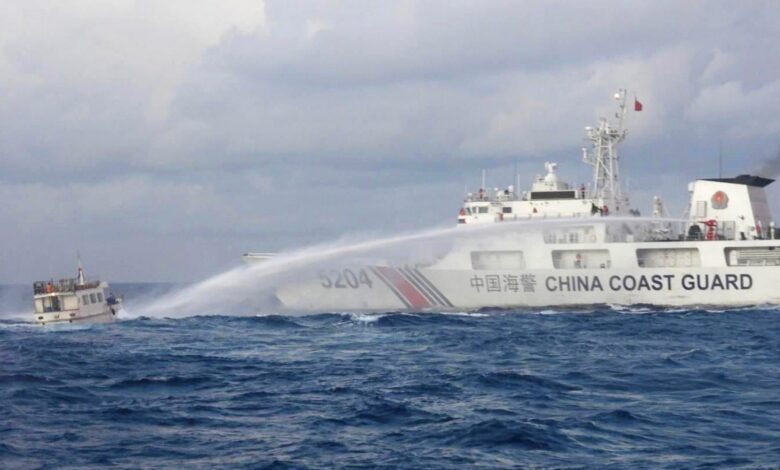
Manila, Philippines – On February 2, 1995, just over two years after the last American soldiers had left the Philippines, a Filipino navy patrol boat found a newly built structure on stilts flying a Chinese flag on a submerged reef, some 240 kilometres (149 miles) off the Philippine island of Palawan.
The sailors had gone to Mischief Reef in the South China Sea after a Filipino fisherman reported being taken captive by Chinese soldiers in the area. Beijing, which claims nearly all of the South China Sea, dismissed the allegations and insisted that the octagonal structure on the reef – which was equipped with a satellite dish for communications with the Chinese mainland – was merely a shelter for its fishermen.
Today, Mischief Reef is a fully fledged Chinese military outpost, with a 3,000-metre airfield runway, radar systems and warehouses probably housing surface-to-air missile systems on land reclaimed from the sea.
Chinese navy and coastguard vessels patrol the area, harassing Filipino troops, including by using military-grade lasers and water cannon, and blocking Filipino fishermen from the rich fishing grounds in the waterway by ramming their boats and seizing their catches.
The reef, which is submerged at high tide and part of the Spratly Islands, is nearly 1,000km (620 miles) from China’s Hainan Island.
Beijing has now fully militarised a total of three islands in the Spratlys, according to officials in the United States, and maintains seven military outposts in the area.
Across the top military brass in the Philippines, the view is that China would not have taken over Mischief Reef had US forces stayed in the country.
“If in 1992, the US didn’t leave, I don’t think that we will be losing Mischief Reef,” said Jay Tarriela, spokesman for the Philippine Coast Guard. “The Philippine government – during the time that we have enjoyed the security umbrella of the United States – have tremendously strengthened the military deterrence of the Philippine government. So supposing that those bases are still here, I am 100 percent sure that none of all this maritime features will be taken away from us.”
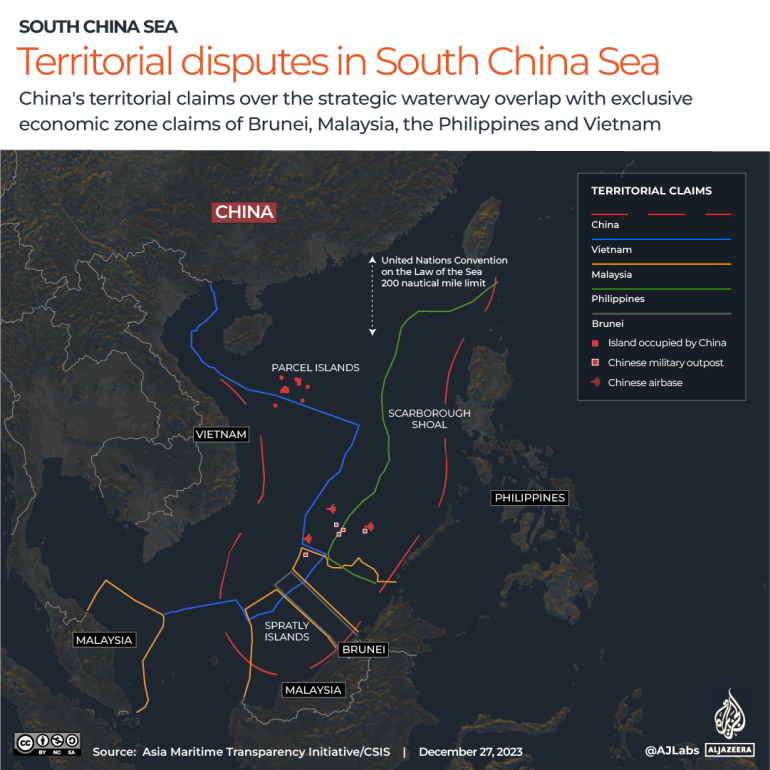
Now, three decades after the Philippines ended a vast US military presence that began with the capture of the archipelago from Spain in 1898, American troops are again returning.
Philippines President Ferdinand Marcos Jr, who took office last year, has pivoted to Washington, in a reversal of his predecessor’s policy, expanding the US’s military footprint in the country under their Mutual Defense Treaty of 1951 and a pact called the Enhanced Defense Cooperation Agreement (EDCA). He has now authorised the Pentagon to pre-position equipment and rotate forces through a total of nine sites in the Philippines. Some are in Palawan, near the disputed Spratlys, and some face north towards Taiwan, the self-governed island that Beijing claims as its own territory.
Marcos has also extracted a promise from US President Joe Biden that American troops will come to the Philippines’ defence in the event of an attack on the Southeast Asian nation’s armed forces in the South China Sea, something Washington had been reluctant to commit to earlier.
“It is only natural for the Philippines to look to its sole treaty partner in the world to strengthen and to redefine the relationship that we have and the roles that we play in the face of those rising tensions that we see now around the South China, Asia Pacific and Indo-Pacific region,” Marcos told Biden during a summit in Washington, DC, in May.
While Marcos Jr’s decisions have largely been driven by the South China Sea territorial dispute, he has also shared concerns about the impact of a possible Chinese invasion of Taiwan, saying that “it’s very hard to imagine a scenario where the Philippines will not somehow get involved”.
Beijing, however, has hit back at the expansion of EDCA, saying the move will “seriously harm Philippine national interests and endanger regional peace and stability”. The decision would “drag the Philippines into the abyss of geopolitical strife”, it claimed. China’s ambassador to Manila, Huang Xilian, also advised the Philippines in April to “unequivocally oppose ‘Taiwan independence’ rather than stoking the fire by offering the US access to the military bases near the Taiwan Strait”.
Analysts say the Philippines is a prime example of how China’s actions have driven its neighbours closer to Washington, which has been strengthening an arc of alliances in the Asia Pacific to deter China. These include allies such as Japan, which has protested over Chinese incursions near the disputed Senkaku or Diaoyu islands, and non-aligned India, which fought a bloody border battle with Chinese troops in the Galwan Valley in the Himalayas in 2020.
These territorial disputes “alienate other regional countries with whom [China] often has very close economic ties” said Joshua Kurlantzick, senior fellow for Southeast Asia at the Council on Foreign Relations, a US-based think tank. “And so in some ways it hurts China’s image in the region and its soft power and perhaps in some ways its influence,” he said.
‘Problems remain’
Marcos’s pushback against China in the South China Sea marks a reversal from the policy of his predecessor, Rodrigo Duterte.
Duterte took office in 2016, shortly before a United Nations-backed tribunal ruled that China’s “Nine Dash Line” claims to the South China Sea – which overlap with the Exclusive Economic Zone claims of the Philippines, Vietnam, Taiwan, Brunei and Malaysia – had no legal basis. But Duterte downplayed the ruling, shelving talks on the issue after declaring a “separation” from the US and pivoting towards China. He then threatened to terminate the US-Philippine Visiting Forces Agreement, which serves as the legal foundation for Washington’s bilateral military cooperation in the Philippines, suspended joint military exercises and froze US access to Philippine bases under the EDCA.
Instead, he turned to China, seeking financing for infrastructure projects throughout the country as part of his “Build Build Build” programme. That year, China pledged $6bn in official development assistance, $3bn in loans, and $24bn in investments to the Philippines. But as the end of Duterte’s term approached, only a small fraction of that financing and investment had reportedly materialised.
Enrique Manalo, the Philippines’ foreign secretary, told Al Jazeera that while Duterte’s approach helped Manila to enter into dialogue with China, it did not help with the resolution of the territorial disputes.
“It enabled us in many ways to create mechanisms for dialogue. And at least gave us a better opportunity to exchange views and discuss critical issues, including the South China Sea. So, it did create the venue for that … But that being said, the problems remain,” he said in an interview in July.
“The [Chinese] presence is still there. We had harassment incidents before and they’re still continuing and the danger is that they most likely, they continue. The danger is that they could escalate to something even more. So that’s something which we’re also concerned with,” he said. “That’s the challenge for us and we have raised it into China on many, many occasions… but the situation remains the same.”
![Enrique Manalo [Ron Lopez/ Al Jazeera]](https://www.aljazeera.com/wp-content/uploads/2023/12/Manalo-5-1703829899.jpg?w=770&resize=770%2C513)
In this context, the Philippines’s decision to boost military ties with the US and increase the number of EDCA sites was “purely for our own national interests or aimed at enhancing our own security”, he said. The moves would especially help the Philippines in the event of natural disasters, he added, while declining to comment on whether the bases could be used in a crisis over Taiwan
“That would depend on whatever we agree on with the situation. It’s difficult to comment on it now,” Manalo said. “But just to say that they are – at the moment, that they are designed, that the main priority there is to be in a position to provide humanitarian assistance and disaster relief. And then any use or type of equipment or even type of personnel that depends on would depend on prior agreements between the Philippines and the United States.”
‘Bombarded by flooding, typhoons’
Three of the four new sites the Philippines has given US troops access to are in the north of the main Philippine island of Luzon, facing Taiwan. They are the Camp Melchor Dela Cruz in Isabela province, and Lal-lo airport and Camilo Osias Naval Base in the Cagayan province.
The two provinces, home to nearly three million people, lie in the Cagayan valley. There, the Philippines’s longest river, the Rio Grande de Cagayan, twists through endless fields of corn and rice. Bounded by the Sierra Madre mountains to the east, the region is hit by some 20 typhoons every season, causing widespread flooding and destruction.
At Camp Melchor Dela Cruz, a sprawling and forested military camp home to the Philippines’ fifth infantry division, the US has committed to building warehouses, a landing pad for rotary aircraft, a joint training facility as well as a command fusion centre, according to spokesman Major Rigor N Pamittan. The warehouses will facilitate “the prepositioning of some of the assets of the US armed forces”, he told Al Jazeera.
“We are welcoming all the projects,” he said. “We are bombarded by flooding and typhoons.” US investment in the base as well as joint exercises will help Philippine troops respond better to any humanitarian disasters, he said.

The US will also upgrade the Lal-lo airport, a desolate airstrip on the tip of Luzon island, some 200km (124 miles) from the southern coast of Taiwan, that sees occasional chartered flights to the nearby tourist town of Santa Ana, as well as the Camilo Osias Naval Base.
The Philippine government wants funding to rehabilitate the airstrip, build accommodation for troops, buy a new generator and upgrade its electrical systems. And at Camilo Osias, it has asked for funding to build a perimeter fence, road networks with drainage, fuel storage, landing pads, and warehousing.
Romeo Brawner Jr, the chief of staff of the Filipino armed forces, told Al Jazeera the Philippines needed to leverage its alliance with the US due to a lack of resources.
“Because of the limitation in terms of our financial capability as a nation, we cannot really buy a lot of ships, a lot of aeroplanes, radars, anti-tank weapons, our air defence systems,” he said. “We have then to leverage our alliances with the United States, our only ally, and our partners – Australia, Japan, South Korea, and the other ASEAN countries, countries from Europe, even the Americas,” he said.
The military chief insisted that the main purpose of the EDCA sites was for humanitarian assistance and disaster response in the Philippines, even in the event of a possible Chinese invasion of Taiwan.
“A crisis in Taiwan would involve, for instance, an influx of people coming from Taiwan. If they would like to leave Taiwan and go to other countries, then they would have definitely either come to the Philippines or to Japan. And this would create scenarios that would involve again, humanitarian assistance and disaster response. Aside from that, if in case something really happens, one of our problems would be to repatriate our Filipino workers. And we will definitely be launching our operations from the north, bringing our Filipino workers to safety, here in our land,” he said.
Brawner said he was not “worried about agitating China”.
“What we are really trying to do right now is we are promoting the interests of our country,” he said. “Despite the fact that we lack modern weapons, we lack the big items, we are confident because one of the directions that we’re pursuing is developing the alliances and the partnerships with like-minded nations. Again, this is not just the problem or the interest of the Philippines for us to have a free and open Indo-Pacific. But more importantly, we are also promoting a rules-based international order. And we have like-minded nations to back us up with that.”
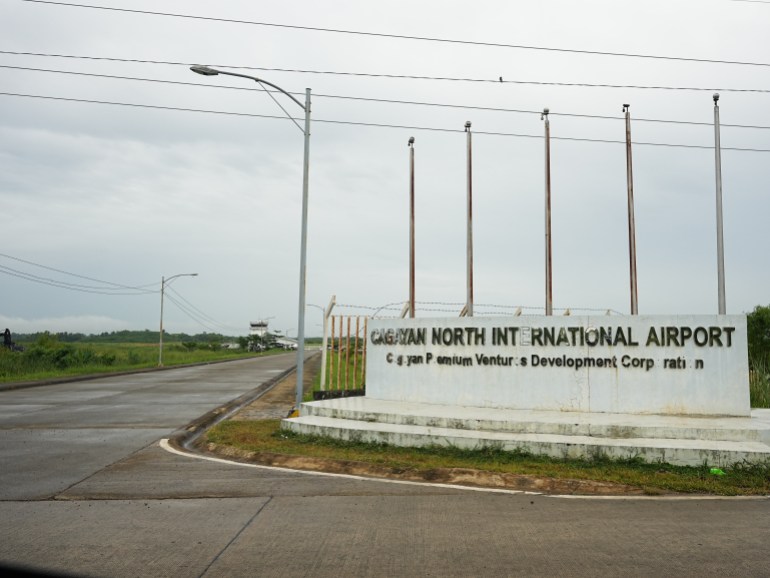
Anxiety in Cagayan
In Cagayan, however, there is fear that the Philippines’ decision to boost ties with the US could invite conflict.
Manuel Mamba, the province’s governor, said he sees the EDCA sites as a “magnet of attack by the enemies of the United States”.
The politician, who won office in 2016, said he wanted to revitalise the province’s economy by developing tourism and a river port there. He wants to attract tourists from China, South Korea and Japan, and dredge the Aparri port – which has been closed for 20 years – so it can ship the province’s agricultural products to the Philippines’ northern neighbours. Mamba worries that EDCA expansion could disrupt those plans.
“There will be more benefits if we could reconnect ourselves with our neighbours in the north. Because my province is the nearest and we have been disconnected from them,” he said. “If a war is hanging on all of us, who will be investing in us? That is why I have always been saying that we do not have enemies. Everyone is our friends. And we want to have international economic exchanges with them.”

The people of Cagayan are fearful of conflict, too.
Ofelia P Ravelo, a 53-year-old navy reservist who trained with US soldiers on disaster relief last year, said people of the province were “afraid that there might be war here”.
During the US-Philippines’s annual Balikatan joint exercises this April, when planes zoomed overhead, many people wondered if a war had broken out, she said.
“It’s peaceful here,” Ravelo told Al Jazeera. “If the enemy of the US knew they are here, they will come here. For me, it’s better that the US don’t come here.”
Near the Camilo Osias base, Evelyn Umengan, a 45-year-old vendor selling meat and vegetables said, “It’s good if they [US troops] are going to help us in time of disasters.” Umengan, who lives near the sea, said strong typhoons regularly inundate her store. “But we also feel afraid, because if there’s a lot of them, it could attract their enemies,” she added.
Increased tensions
As the Philippines has ramped up ties with the US, tensions have grown with China in the South China Sea.
In February, the Philippines accused China’s coastguard of directing a “military-grade laser” at its troops living on a dilapidated warship on Second Thomas Shoal near Mischief Reef. The Philippines in 1999 grounded the BRP Sierra Madre on the shoal in a bid to boost its claims over the Spratly Islands, and the handful of troops garrisoned on the run-down vessel depend on regular resupply missions to survive their remote assignment.
China has repeatedly urged the Philippines to remove the grounded ship, and Manila in turn has called on Beijing to also remove all “illegal structures” built within its EEZ.
The laser incident was followed by multiple confrontations.
In August, the Philippines accused China of using a water cannon against Filipino supply boats delivering food, fuel and water to the Sierra Madre troops. And in October, the Philippines accused the Chinese coastguard of intentionally colliding with its resupply boats in the area. Earlier this month, the Philippines again accused China of firing water cannon at its boats and ramming others, causing serious engine damage.
Manila called the actions of the Chinese vessels a “serious escalation”, while Beijing accused the Philippine boats of trespassing on its territory.
The Chinese foreign ministry last week warned the Philippines that ties between the two countries were at a “crossroads” and said that if Manila misjudged or colluded with “ill-intentioned” forces, Beijing would defend its rights and respond resolutely.
Despite the rising tensions, analysts in Manila say traditional methods of diplomacy with China have failed and the Philippines has no choice but to work with allies.
“Whatever action the Philippines takes to protect its national interest will always be construed by China as a provocation,” said Rommel Jude G Ong, a professor at the Ateneo School of Government and a former Filipino naval officer.
“The best course of action for the Philippines is to strengthen its ability to deter China unilaterally and in concert with the US and other strategic partners,” he added.


